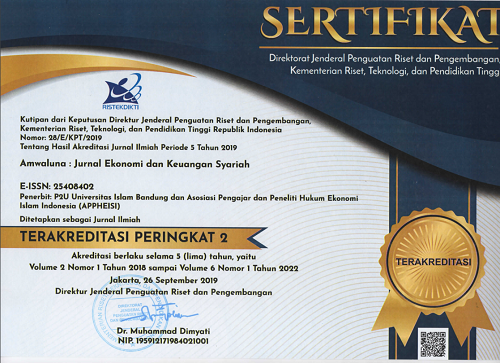THE ROLE OF GOVERNMENT POLICY IN BOOSTING THE ISLAMIC MICROFINANCE INSTITUTIONS PERFORMANCE IN INDONESIA
Abstract
In building a successful Islamic Microfinance Institutions (IMFIs) performance, many factors must be considered based on a multi-element point of view. This study aims to build key factors affecting IMFIs performance using multi-perspective and multi-criteria methods. This study uses an analytic network process (ANP) to calculate the degree of influence given by the IMFIs performance criteria and factors. Primary and secondary data collection techniques are used to collect required data for this research. The primary data are collected through questionnaires and interviews. A purposive sampling technique to collect primary data is used to the 26 local BPRS, 11 BMT including on the islands of Java, Sumatra and Sulawesi as a three biggest island of Indonesia. The results of the study find, internal and external management aspects are two main problems affecting IMFIs and five main solutions to increase their financing are regulatory, management, institutions, competencies, and partnerships.
Keywords
Full Text:
PDFReferences
Abbas, K., & Shirazi, N. (2015). The key players’ perception on the role of Islamic microfinance in poverty alleviation: The case of Pakistan. Journal of Islamic Accounting and Business Research, 6(2), 244-267.
Agarwal, A., Shankar, R., & Tiwarib, M.K. (2006). Modeling the metrics of lean, agile and leagile supply chain: An ANP-based approach. European Journal of Operational Research, 173(1), 211–225.
Ahmad, A.U.F., & Ahmad, A.B.R. (2009). Islamic microfinance: the evidence from Australia. Humanomics, 25(3), 217-235.
Antonio, M.S. (2008). “Islamic microfinance initiatives to enhance small and medium-sized enterprises”, in Greg, F. and Sally, W. (Eds), Expressing Islam: Religious Life and Politics in Indonesia, ISEAS Publishing, available at: http://ehis.ebscohost.com/eds/pdfviewer/pdfviewer?sid9e3bc053-5089-4575-9bb7-fcc2b6ee43a2%40sessionmgr4002&vid2&hid4113 (Accessed 10 August 2020), 251-266.
Armstrong, K., Ahsan, M., & Sundaramurthy, C. (2018). Microfinance ecosystem: How connectors, interactors, and institutionalizers co-create value. Business Horizons, 61(1), 147–155. https://doi.org/10.1016/j.bushor.2017.09.014.
Bashar, T., & Rashid, S. (2012). Urban microfinance and urban poverty in Bangladesh. Journal of the Asia Pacific Economy, 17(1), 151–170. https://doi.org/10.1080/13547860.2012.640019.
Chikalipah, S. (2018). Credit risk in microfinance industry: Evidence from sub-Saharan Africa. Review of Development Finance, 8(1), 38–48. https://doi.org/10.1016/j.rdf.2018.05.004.
De Fontenay, C., & Wood, C. (2018). Is microfinance raising village income? The issue of excess entry. Economics Letters, 165, 17–20. https://doi.org/10.1016/j.econlet.2018.01.016.
Eversole, R. (2003). Help, Risk and Deceit: Microentrepreneurs Talk About Microfinance. Journal International Development, 179-188.
Feibert, D.C., Sørup, C.M., & Jacobsen, P. (2016). Using the Analytic Network Process(ANP) to assess the distribution of pharmaceuticals in hospitals – a comparative case study of a Danish and American hospital, 5th World Conf Prod Oper Manag - Join P&OM Forces Worldw Present Futur Oper Manag;. p. 10.
Hamada, M. (2010). Commercialization of microfinance in Indonesia: the shortage of funds and the linkage programs. The Developing Economies, 48 (1), 156-176.
Hassan, A. (2015). Financial inclusion of the poor: from microcredit to Islamic microfinancial services. Humanomics, 31(3), 354-371.
Hassan, S., Abdul Rahman, R., Abu Bakar, N., Mohd, R., & Muhammad, A.D. (2013). Designing islamic microfinance products for islamic banks in Malaysia. Middle-East Journal of Scientific Research, 17(3), 359-366.
Hassan, A., & Saleem, S. (2017). An Islamic microfinance business model in Bangladesh: Its role in alleviation of poverty and socio-economic well-being of women. Humanomics, 33 (1), 15-37.
Hermes, N. (2014). Does microfinance affect income inequality?. Applied Economics, 46 (9), 1021–1034. https://doi.org/10.1080/00036846.2013.864039.
Chen, H.H., Kang, H., Xing, X., Lee, A.H.I., & Tong, Y. (2008). Developing new products with knowledge management methods and process development management in a network. Computers in Industry, 59, 242–53.
Juwaini, A., Rambe, M., Mintarti, N., & Febrianto, R. (2010). BMT (Baitulmaal wa Tamwil) Islamic microfinance services for the poor, paper presented at ISO/COPOLCO Workshop, Bali, May, available at: www.scribd.com/document/186013286/BMT-Islamic-Microfinancial-Services-forthe-Poor (accessed 07 September 2020).
Karim, N., Tarazi, M., & Reille, X. (2008). Islamic Microfinance: an emerging market niche, Focus Note, 49, CGAP, August.
Kheybari, S., Rezaie, F.M., & Farazmand, H. (2020). Analytic network process: An overview of applications. Applied Mathematics and Computation, 367, 124780.
Kikkawa, K., & Xing, Y. (2014). Financial inclusion in Indonesia: a poverty alleviation strategy, Financial Inclusion in Asia Country Surveys, Asian Development Bank Institute, 45-61.
Machado, V.H., Barroso, A.P., & Machado, V.C. (2014). An Analytic Network Process model to support decision making in a pharmaceutical supply chain. In: 2013 IEEE International Conference on Industrial Engineering and Engineering Management. 1612–1616 New York. doi:https://doi.org/10.1109/IEEM.2013.6962682.
Maulana, H., Razak, D.A., & Adeyemi, A.A. (2018). Factors influencing behaviour to participate in Islamic microfinance. International Journal of Islamic and Middle Eastern Finance and Management, 11 (1), 109-130.
Matul, M., & Tsilikounas, C. (2004). Role Of Microfinance In The Household Reconstruction Process In Bosnia and Herzegovina. Journal of International Development, 429-466.
Obaidullah, M. (2015). Enhancing food security with Islamic microfinance: insights from some recent experiments. Agricultural Finance Review, 75 (2), 142-168.
Financial Service Authority. (2019). Islamic Banking Report. Jakarta.
OJK. (2020). Statistik Perbankan Syariah - November 2020.
Rusydiana, A. S., & Devi, A. (2013). Challenges in Developing Baitul Maal wat Tamwiil (BMT) in Indonesia using Analytic Network Process (ANP). Business and Management Quarterly Review (BMQR), 4(1), 51-62.
Saaty, T.L. (1980). The Analytic Hierarchy Process. McGraw-Hill, New York.
Saaty, T.L. (2006). Decision Making With The Analytic Network Process. Boston: Springer.
Saaty, T.L., & Vargas, L.G. (2013). The Analytic Network Process. Decision Making Analytic Network Process. 195, 1–40.
DOI: https://doi.org/10.29313/amwaluna.v5i1.6935
Refbacks
- There are currently no refbacks.
Editorial Office:
Syariah Faculty, Universitas Islam Bandung
Jalan Tamansari No. 24-26 Kota Bandung

Amwaluna : Jurnal Ekonomi dan Keuangan Syariah is licensed under a Creative Commons Attribution-NonCommercial-ShareAlike 4.0 International License.
- https://jurnal.narotama.ac.id/
- https://proceeding.unmuhjember.ac.id/
- https://random.polindra.ac.id/
- https://scholar.ummetro.ac.id/
- https://www.spb.gba.gov.ar/campus/
- https://revistas.unsaac.edu.pe/
- https://ejournal.uika-bogor.ac.id/
- https://www.iejee.com/
- https://e-journal.iainptk.ac.id/
- https://catalogue.cc-trieves.fr/
- https://journal.umpalopo.ac.id/
- https://revistas.tec.ac.cr/
- https://ojs.ucp.edu.ar/
- https://ihcway.sakura.ne.jp/
- http://www.apps.buap.mx/
- http://media-ojs.vls.icm.edu.pl/
- https://jurnal.untidar.ac.id/
- https://ojs.adzkia.ac.id/
- https://journal.unifa.ac.id/
- https://ojs.unpatompo.ac.id/
- https://jurnal.staim-probolinggo.ac.id/
- https://jurnal.iainambon.ac.id/
- https://ejournal.um-sorong.ac.id/
- https://ejurnal.univamedan.ac.id/
- https://imagisite.usermd.net/
- https://majta.creson.edu.mx/
- https://ejournal.unperba.ac.id/
- https://journal.stitpemalang.ac.id/
- https://ejournal.unsa.ac.id/
- https://revistas.urp.edu.pe/
- https://www.kar-group.com/
- https://jurnal.ppi.ac.id/
- https://sec.ssu.ac.kr/
- https://jurnal.iaii.or.id/
- https://studia.reviste.ubbcluj.ro/
- https://ejournal.uki.ac.id/
- https://ijaphc.unibuc.ro/
- https://gf.unsa.ba/
- https://e-journal.trisakti.ac.id/
- https://jurnal.fmipa.unmul.ac.id/
- https://ejurnal.unima.ac.id/
- https://murninetsv2.planmalaysia.gov.my/
- https://journals.proindex.uz/







